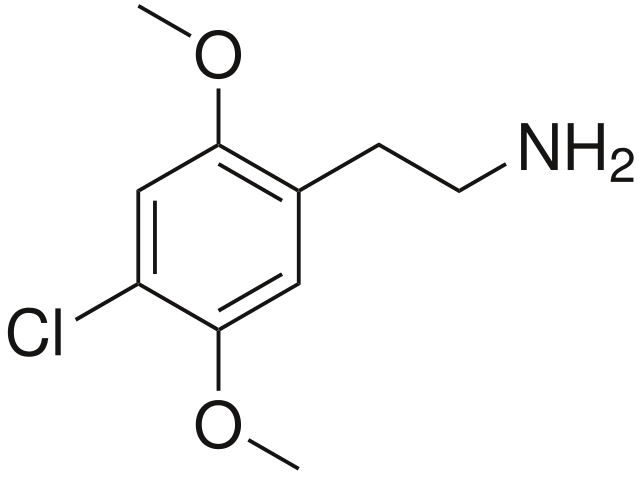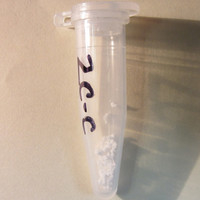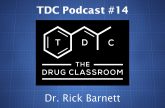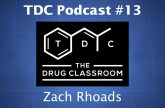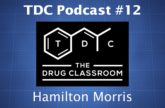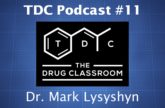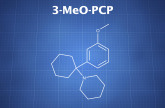2C-C is a substituted phenethylamine with psychedelic effects. It’s known for producing fairly relaxed experiences that tend to be comfortable or at least manageable in terms of physical and mental activity.
It was first synthesized in the 1980s and publicized in the 1990s, but it’s never become a popular drug. The substance remains a research chemical that’s almost exclusively purchased online. 2C-C is substantially less popular than LSD, psilocin, and even 2C-B.
2C-C = 2,5-Dimethoxy-4-chlorophenethylamine
PubChem: 29979100
Molecular formula: C10H14ClNO2
Molecular weight: 215.677 g/mol
IUPAC: 2-(4-chloro-2,5-dimethoxyphenyl)ethanamine
Contents
Dose
Oral
Light: 20 – 30 mg
Common: 30 – 50 mg
Strong: 50 – 70 mg
Intranasal
Light: 5 – 15 mg
Common: 15 – 25 mg
Strong: 25+ mg
Timeline
Oral
Total: 4 – 6 hours
Onset: 00:30 – 01:30
A lot of users report some changes within 30 to 45 minutes, but it can take up to 1.5 hours (occasionally longer) for the psychedelic effects to become noticeable.
Intranasal
Total: 3 – 5 hours
Onset: 00:10 – 00:20
After the drug wears off it doesn’t keep people awake very long. Sleep is often possible within a few hours and people feel sober pretty fast. By the next day you’re usually normal, with the exception of potential mood changes, both positive and negative.
Experience Reports
Effects
Positives
- Open eye visuals
- Closed eye visuals
- Relaxation
- Insightful thinking
- Increased care for others
- Stimulation
- Euphoria
- Music enhancement
- Auditory hallucinations
Negatives
- Confusion
- Anxiety
- Nausea
- Increased heart rate
- Increased blood pressure
- Impaired coordination
- Tension
2C-C is typically viewed as a recreational and pretty relaxing psychedelic, with neither its physical nor mental effects being overwhelming or difficult at common doses. These qualities have led to some people calling it a good drug for people new to psychedelics.
There are two common views of the substance. One is that it’s a pleasant recreational and sometimes introspective or entactogenic psychedelic. The other is that it’s boring and not worth it.
A very harsh or negative view of 2C-C is pretty uncommon, so the biggest critique tends to be that it’s underwhelming.
It’s one of the most relaxing psychedelic phenethylamines. Sometimes that means it’s sedating (people occasionally even feel like they could sleep on it). Other times it’s neutral/stimulating with its energy, yet still relaxing in terms of how comfortable you feel in your body and mind. Even if it lowers your energy level or makes it nice to lie down, it’s usually still possible to get up and be active if you want to.
Words like “tranquil” and “comfortable” have been applied to the experience, though they definitely won’t apply for all users and at all doses.
Because it doesn’t really feel like a stimulant, it’s distinct from other members of the 2C-x series, the DOx series, and LSD.
Come Up
The come up period is the main time 2C-C can feel less comfortable. Nausea, tension, jitteriness, and restlessness are more common. They’ll usually subside in 30-60 minutes. Nausea is still pretty rare compared to other psychedelics, including other 2C-x drugs, and vomiting is very uncommon.
Its come up is sometimes compared to the initial feel of MDMA or the buzz offered by alcohol. Neither are perfect comparisons though. It simply has the potential to offer effects that feel similar to elements of those drugs, such as a pleasant mood lift, slight perception changes, a general sense of alteredness, a prosocial mindset, and a good body high.
Visuals
The visual changes will vary by dose and user. Common doses tend to provide noticeable and significant hallucinations, such as breathing, patterns, object movement, and colors (both enhancement of colors and hallucinating new ones).
Patterns, colors, and other effects are also frequently present when you close your eyes. The closed-eye experience can let people enter a sort of “internal world” where they feel physically comfortable, relaxed, and dissociated from their body.
However, for whatever reason, there are some users who mainly get a mood or bodily effect at common doses, not a prominent visual response.
When you reach stronger doses, it can be a pretty intense drug in terms of visual hallucinations.
Headspace
The substance isn’t very confusing or forceful with its effects, especially at common doses. This can be a nice quality, but the flip-side is that it’s also potentially less likely to deliver insightful and creative thinking. As a significantly altered mental state may be viewed as a key part of the psychedelic experience, some users come away feeling underwhelmed and disappointed if it’s not present during a 2C-C experience.
At common doses you’ll usually maintain your ability to communicate, though it could be moderately impaired and communication can be anxiety-provoking.
The chance of entering a psychotic or very confused state is pretty low. It’s a clear-headed psychedelic overall, but that doesn’t make paranoia, delusional thinking, and panic attacks impossible.
Even though it may often be less intense, it has the capacity to yield insightful mental states. 2C-C can make it easier to explore personal or spiritual topics with relatively low anxiety and confusion.
It also has the potential to facilitate open communicate between people. There are some prosocial and caring effects that contribute to an appreciative mental state. In this sense it has some entactogenic qualities, even if it’s not going to truly feel like an entactogen when all aspects of the experience are considered.
Erotic thinking is sometimes encountered and it may be paired with an enhancement of sexual activity. This stems from a combination of its mental effects and tactile enhancement, which can make everything from lying in a warm bed to sex to a shower more enticing. It’s still more common for people to simply feel closer to their friends or a partner in a non-sexual way.
Another effect that has sometimes been reported is an increase in laughter or an enhancement of humor.
Physical
The body high is usually pleasant. Some common elements include warmth, buzzing, and fuzziness. But negatives like tension or an unpleasant sensation of energy in the body can occur.
Coordination is often impaired in a sedative-like way, even to the point of experiencing heaviness in your limbs. Though lightness/floatiness are also common when moving.
A minority of users have uncomfortable periods of hot flashes and/or cold sensations, as if their temperature is fluctuating. And some portion also get a headache during or after the experience. The chance of getting a headache may be reduced if you keep up your water intake while on the drug.
Chemistry & Pharmacology
Chemistry
2C-C is a substituted phenethylamine and a member of the 2C-X series, meaning it has a methoxy group at both the 2 and 5 positions, and another substitution at the 4 position.
In the case of 2C-C, the substituent at the 4 position is a chlorine atom.
The amphetamine counterpart of 2C-C is DOC.
Pharmacology
It’s known to function as an agonist at serotonin receptors, including 5-HT2A, a primary target for psychedelics. It also binds, albeit with a lower affinity, to 5-HT1A and 5-HT2C. Though it has some affinity for non-serotonin receptors, it’s usually too low for the binding to be relevant.
Compared to 2C-B, it has a lower selectivity for 5-HT2A over 5-HT1A, though it remains far more selective for 2A.
Studies
(Rickli, 2015)
- Receptor/transporter interactions using HEK-293 cells (all are human form unless otherwise noted)
- 5-HT1A
- Affinity (Ki) (antagonist): 0.19 μM
- 5-HT2A
- Affinity (Ki) (antagonist): 0.0130 μM
- EC50: 0.20 μM
- Intrinsic activity: 49%
- 5-HT2B
- Affinity (Ki) (antagonist): 0.28 μM
- Intrinsic activity: 81%
- 5-HT2C
- Affinity (Ki) (antagonist): 0.090 μM
- α1A adrenergic
- Affinity (Ki): 13 μM
- α2A adrenergic
- Affinity (Ki): 0.53 μM
- D1
- Affinity (Ki): 13 μM
- D2
- Affinity (Ki): 2.1 μM
- D3
- Affinity (Ki): 17 μM
- H1
- Affinity (Ki): 24 μM
- TAAR1rat
- Affinity (Ki): 0.11 μM
- TAAR1mouse
- Affinity (Ki): 4.1 μM
- NET
- Affinity (Ki): >30 μM
- IC50: 93 μM
- DAT
- Affinity (Ki): >30 μM
- IC50: 305 μM
- SERT
- Affinity (Ki): 24 μM
- IC50: 74 μM
History
1983
It was synthesized by Alice Cheng and Neal Castagnoli Jr at the University of California, San Francisco. They made it as part of an investigation of 6-hydroxydopamine analogs, but it was only an intermediate.
1991
Alexander Shulgin described its synthesis and effects in PiHKAL. The 2C-C entry in PiHKAL reported an oral dose of 20 – 40 mg and a duration of 4 – 8 hours. It was described as lacking visuals at 24 mg, but offering a “lot of visuals” by 40 mg. It was also noted to be “sedating in some ways,” though not to the point of sleep.
2000s
Experience reports began showing up online and they’ve become more common over time.
2005
(Lee, 2013) – Drug detection stats in Taiwan from 1991 to 2011. The paper used data from urine and non-urine drug seizure samples.
2C-C was first detected in the country in June 2005.
2010s
(Vidal Gine, 2014) – 2009 to 2012 drug analysis data from Energy Control was reported.
2C-C was among those detected as an adulterant in the controlled drug market. Out of 173 analyzed samples, 2C-C was only detected once and was reportedly found alongside 25C-NBOMe in an “LSD” sample.
July 2012
The substance was added to Schedule 1 in the US alongside other 2C-x substances and various other drugs.
Legality
United States
Schedule 1
Other
Australia: Illegal. There’s a blanket ban covering all 2C-x drugs and other methoxyphenethylamines.
Canada: Schedule 3
UK: Class A
Safety
The safety of 2C-C is unknown, largely due to it being a research chemical. It’s best to use common doses, infrequently, and without combinations.
Among the likely physical risks are increased cardiovascular stress and a lower seizure threshold, making the drug contraindicated in people with a cardiovascular disorder or epilepsy.
Some of the likely psychological risks include temporary psychosis, confusion, panic attacks, and anxiety. It’s unwise to use the drug if you have a mental health condition.
Risky Combos (list may not be complete)
- Other psychedelics
- Stimulants
- Tramadol
Test Videos
References
Cheng, A. C., & Castagnoli, N. (1984). Synthesis and physicochemical and neurotoxicity studies of 1-(4-substituted-2,5-dihydroxyphenyl)-2-aminoethane analogs of 6-hydroxydopamine. Journal of Medicinal Chemistry, 27(4), 513–520. https://doi.org/10.1021/jm00370a014
Giné, C. V., Espinosa, I. F., & Vilamala, M. V. (2014). New psychoactive substances as adulterants of controlled drugs. A worrying phenomenon? Drug Testing and Analysis, 6(7–8), 819–824. https://doi.org/10.1002/dta.1610
Lee, S. F., Hsu, J., & Tsay, W. I. (2013). The trend of drug abuse in Taiwan during the years 1999 to 2011. Journal of Food and Drug Analysis, 21(4), 390–396. https://doi.org/10.1016/j.jfda.2013.09.003
Rickli, A., Luethi, D., Reinisch, J., Buchy, D., Hoener, M. C., & Liechti, M. E. (2015). Receptor interaction profiles of novel N-2-methoxybenzyl (NBOMe) derivatives of 2,5-dimethoxy-substituted phenethylamines (2C drugs). Neuropharmacology, 99, 546–553. https://doi.org/10.1016/j.neuropharm.2015.08.034










